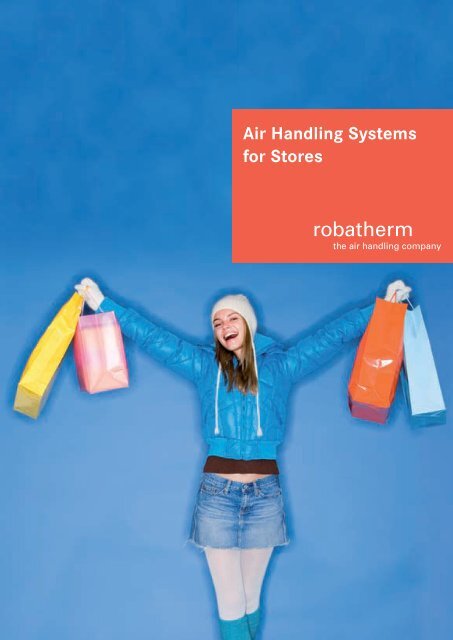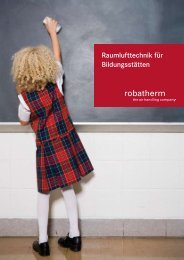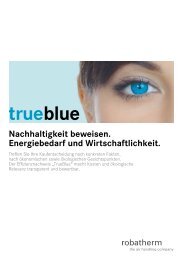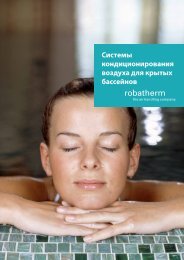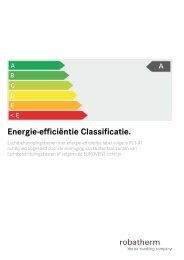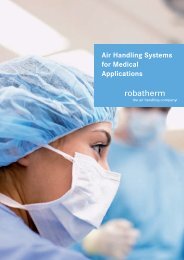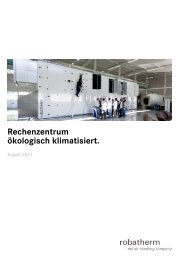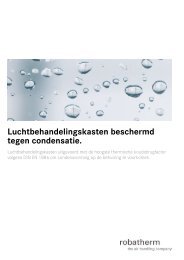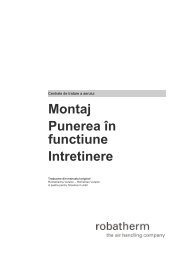English - robatherm
English - robatherm
English - robatherm
Create successful ePaper yourself
Turn your PDF publications into a flip-book with our unique Google optimized e-Paper software.
Air Handling Systems<br />
for Stores
ECE, Stadtgalerie Passau
Applications | 1<br />
Air Handling Systems<br />
for Stores:<br />
Good Indoor Climate<br />
for Better Sales.<br />
Properly air-conditioned stores are more attractive to the customer.<br />
Customers’ dwell times increase; so do sales.<br />
Air handling thus increases turnover of goods.<br />
Consumer researchers agree on<br />
this point: The customer’s mood has a decisive<br />
influence on buying behaviour.<br />
Apart from decoration and the merchandise on<br />
offer, numerous other factors strongly influence<br />
the customer’s feeling of comfort. Principal<br />
among these, however, are lighting and the<br />
indoor air conditions in the store. They act on a<br />
sub-conscious level, triggering the wish to buy<br />
again. This turns walk-in customers into regulars,<br />
giving a business a further economic edge.<br />
The advertising budget required for regular<br />
customers, for instance, will be lower by a<br />
factor of 4 to 6 than that allocated to prospects.<br />
Moreover, regular customers actively acquire<br />
new customers among their friends and<br />
acquaintances, from which considerable<br />
multiplier effects ensue.<br />
Also, the buying behaviour and interviews with<br />
regular customers convey ample information<br />
on the public image of a business. Regular<br />
customers thus serve as a barometer of opinion<br />
on, e. g., the presentation of the merchandise.<br />
Furthermore, the price more and more becomes<br />
a secondary factor, an emotional bond already<br />
having been established based on positive<br />
experience.<br />
The competition among stores is enormous.<br />
Differences between the numerous DIY stores,<br />
health and beauty retailers, discounters,<br />
furniture stores, supermarkets and shopping<br />
centres lie particularly in ”intrinsic values“.<br />
Comfort conditions offered to the customer<br />
gain more and more importance for better<br />
sales.<br />
Indoor comfort during the summermonths<br />
requires indoor air temperatures between 20 °C<br />
and 22 °C. In most cases, this cannot be<br />
achieved relying solely on natural ventilation<br />
such as window ventilation. Differently used<br />
rooms exhibiting different heat loads also<br />
require controlled air supply and extraction.<br />
Air handling systems are, therefore, essential<br />
technical equipment in stores. Only they<br />
can ensure perfect indoor air temperatures,<br />
creating comfort for customers and staff.<br />
This is a further advantage, for the constant<br />
indoor climate ensures constantly high staff<br />
performance.<br />
Air handling systems in stores will, therefore,<br />
quickly pay for themselves.<br />
Air-handling<br />
systems are<br />
essential to ensure a<br />
permanently perfect<br />
indoor climate.<br />
Increased customer<br />
loyalty through<br />
customer satisfaction.<br />
Increased sales<br />
through longer dwell<br />
times.<br />
Improved staff<br />
performance through<br />
comfort.
2 | General requirements<br />
High Demands on<br />
Air Handling Systems.<br />
The air handling system must ensure perfect indoor air conditions at all times while still<br />
allowing economic operation. Many different factors must be taken into consideration.<br />
Demand-based<br />
volume flow control<br />
cuts operating costs<br />
disproportionately.<br />
Heat recovery<br />
is mandatory.<br />
Efficiency<br />
improvements<br />
amortise within<br />
1 to 3 years.<br />
”Free cooling“<br />
reduces cost of<br />
operation.<br />
Internal loads<br />
Lighting makes a particularly significant contribution<br />
to internal heat loads in stores. An intelligently<br />
designed ventilation system is the first<br />
and most important step towards reducing the<br />
cost for operation of the building services. Light<br />
fixtures combined with extract-air terminals, to<br />
give just one example, remove heat where it is<br />
generated.<br />
Operating times<br />
The building services in stores are operated over<br />
extended periods. More than 5,000 h/a are<br />
quite common. A considerable portion of the<br />
time of operation being made up by part-load<br />
operation, demand-based volume flow control<br />
is extremely effective. The cost for operation of<br />
an air handling system exceeds its investment<br />
cost within a few years. Additional investments<br />
for efficiency-improving measures will, in most<br />
cases, amortise within less than three years.<br />
Heat recovery<br />
Only with efficient heat recovery air handling<br />
units (AHUs) can operate in an economically<br />
and ecologically acceptable manner. Therefore,<br />
with the coming into force of the Energy Savings<br />
Ordinance ”EnEV 2009“ in Germany, heat recovery<br />
becomes mandatory for air handling systems<br />
exceeding 4,000 m 3 /h. Furthermore, economic<br />
efficiency shall be checked as per VDI 2071.<br />
Sound attenuation<br />
Acoustically, air handling systems should, of<br />
course, be as unobtrusive as possible. Permissible<br />
sound pressure levels must, therefore,<br />
be reliably observed. Aiming to be close to the<br />
customer, stores are often built in mixed-use<br />
zones or in commercial zones in the direct<br />
vicinity of residential areas.<br />
The relevant regulations regarding ambient noise<br />
thus require careful observance. Sound reflected<br />
by roof-mounted elements or by neighbouring<br />
buildings is not to be neglected in this context.<br />
Chilling<br />
Conventional space cooling uses a centralized<br />
water chiller; decentralized chillers (direct<br />
chillers) are an alternative.<br />
In case of centralized water chilling, the<br />
refrigerant is supplied to the points of use via<br />
lossy pipes.<br />
Direct chilling is particularly convenient where<br />
the cooling power output is required solely for<br />
conditioning the room air.<br />
This solution is often advantageous in department<br />
stores such as furniture or electrical and<br />
electronics stores.<br />
Cool outdoor air can be used for ”free cooling“<br />
in order to control the temperature of the<br />
building during transition periods and at<br />
night-time.
General requirements | 3<br />
Standards and guidelines<br />
The overall energy efficiency of buildings within<br />
the EU is subject to requirements stipulated in<br />
the EPBD (Energy Performance of Buildings<br />
Directive).<br />
This directive has been implemented into German<br />
legislation by the Energy Savings Act (EnEG) and<br />
the Energy Savings Ordinance (EnEV).<br />
Some of the current standards and guidelines,<br />
however, contain contradictory information<br />
regarding system design.<br />
In this case, it is the planner’s responsibility<br />
to take decisions after consultation with the<br />
customer, and to make specific agreements in<br />
writing.<br />
Concerning stores, the requirements laid down<br />
in DIN EN 13779 ”Ventilation for non-residential<br />
buildings“ and – in Germany – particularly<br />
VDI 2082 ”Ventilation and air-conditioning<br />
systems for sales outlets“ shall be taken into<br />
consideration.<br />
Requirements regarding buildings<br />
Energy Performance of Buildings<br />
Directive (EPBD)<br />
Act on the saving of energy in buildings<br />
Energy Savings Act (EnEG) (EnEG) |1<br />
Act on the saving of energy in buildings<br />
Energy Savings Ordinance (EnEV)<br />
Ordinance on energy-saving<br />
thermal insulation and energy-saving<br />
installations in buildings<br />
Important standards and guidelines pertaining to stores<br />
Requirements regarding<br />
air handling systems<br />
DIN EN 13779<br />
Ventilation for non-residential buildings<br />
DIN EN 15251<br />
Indoor environmental input parameters<br />
for design and assessment of energy<br />
performance of buildings<br />
VDI 2082 |1<br />
Ventilation and air-conditioning systems<br />
for sales outlets<br />
Requirements regarding AHUs<br />
DIN EN 13053<br />
Rating and performance for units,<br />
components and sections<br />
DIN EN 1886<br />
Mechanical performance and<br />
measurement methods<br />
VDI 3803 |1<br />
Air-conditioning systems –<br />
Structural and technical principles<br />
DIN V 18599 |1<br />
Energetic evaluation of buildings; Calculation<br />
of the net, final and primary energy<br />
demand for heating, cooling, ventilation,<br />
domestic hot water and lighting<br />
VDI 3807-4 |1<br />
Characteristic values of energy and<br />
water consumption of buildings<br />
MVkVO |1<br />
Model Ordinance on the Construction<br />
and Operation of Stores<br />
VDI 2081 |1<br />
Noise generation and noise reduction in<br />
air-conditioning systems<br />
VDI 6022 |1<br />
Hygienic requirements for ventilation<br />
and air-conditioning systems<br />
AHU Guideline 01 |1<br />
German AHU manufacturers‘<br />
association (Herstellerverband<br />
Raumlufttechnische Geräte e.V.)<br />
General requirements for air handling<br />
units<br />
|1<br />
Valid in Germany; deviating or additional national rules and regulations to be observed as well!
4 | Design requirements<br />
Efficiency Already During<br />
the Conceptual Design Phase.<br />
The planning stage involves specifications which have a decisive influence on the<br />
energy demand and on the cost for operation of air handling systems.<br />
Life cycle cost is<br />
dominated by cost<br />
of operation.<br />
Energy-efficient<br />
air handling units<br />
feature an energyefficiency<br />
label.<br />
Check outdoor air<br />
conditions.<br />
Avoid supply-air<br />
terminals close to<br />
refrigerated display<br />
cases.<br />
Consider savings<br />
potentials of chilling.<br />
The energy demand of a store over its<br />
time of use is the decisive cost factor. In view<br />
of increasing energy prices, efficient operation<br />
must be kept in mind especially during the<br />
planning stage.<br />
The costs of operation and for energy consuption<br />
for central air handling units make<br />
up about 80 % of the total life cycle cost. The<br />
investment cost, on the other hand, is a rather<br />
small contribution, accounting for about 12 %.<br />
This means that here, too, keeping an eye on<br />
efficient equipment and low operating costs is<br />
worthwhile!<br />
”Energy efficiency classes“ have been defined to<br />
allow a harmonized assessment of the energy<br />
efficiency of air handling units. These classes<br />
serve as a practical reference. Combining<br />
optimized built-in components and a low flow<br />
velocity in the AHU casing achieves the highest<br />
energy efficiency classes.<br />
Ambient air conditions<br />
Often used standard design conditions do<br />
not comply any longer to the actual summer<br />
conditions. Caused by the climate change, temperatures<br />
and humilities continuously change.<br />
Extreme weather conditions appear more often.<br />
In addition, geographic differences have a<br />
big impact to the design of air handling units.<br />
Using the tables here below helps avoiding<br />
both, over and low design of equipment for<br />
cooling technology.<br />
Indoor air conditions<br />
If the indoor air temperature outside opening<br />
hours is lowered by just 1 K during winter, the<br />
heating power output required by the building<br />
is reduced by about 6 % and the cooling power<br />
output to be afforded by the refrigerated display<br />
cases is lowered by about 5 %. Time control and<br />
demand-based control of the building services<br />
can yield considerable savings here.<br />
5 % 3 % n Chilling n Lighting<br />
12 %<br />
10 %<br />
5 %<br />
20 %<br />
80 %<br />
65 %<br />
n Operating costs n Investment<br />
n Maintenance n Disposal<br />
Distribution of life cycle cost of a central air<br />
handling unit (full air conditioning system)<br />
n Ventilation<br />
n Other<br />
Power consumption in supermarkets as<br />
investigated by North Rhine-Westphalian Energy<br />
Agency (Energieagentur NRW)
Design requirements | 5<br />
Design parameters for the<br />
meteorological stations<br />
Location<br />
Temperature<br />
[°C] |1<br />
Absolute<br />
moisture<br />
[g/kg] |1<br />
Enthalpie<br />
[kJ/kg] |2<br />
Relative<br />
humidity<br />
[%]<br />
Amsterdam 29,7 13,8 65,1 57,3<br />
Bangkok 34,1 19,6 84,5 62,8<br />
Beijing 11,7 4,8 23,9 61,6<br />
Berlin 28,9 12,6 61,4 55,1<br />
Bratislava 30,0 14,0 66,1 57,3<br />
Copenhagen 26,5 11,2 55,2 56,2<br />
Dublin 24,2 11,5 53,6 66,1<br />
Hanoi 37,5 22,9 96,5 60,6<br />
Helsinki 27,1 11,8 57,4 57,3<br />
Kuala Lumpur 31,6 25,6 97,3 93,7<br />
Ljubljana 29,8 14,7 67,5 60,6<br />
London- 30,8 10,1 56,9 39,7<br />
Gatwick<br />
Madrid 38,2 11,9 69,0 30,8<br />
Manila 33,6 25,6 99,5 83,8<br />
Moscow 30,6 12,8 63,6 50,7<br />
Paris-Orly 30,0 14,9 68,2 60,6<br />
Porto 32,0 13,9 67,8 50,7<br />
Prague 31,0 14,0 67,0 54,0<br />
Rome 30,0 19,6 80,3 79,4<br />
Shanghai 37,0 24,3 99,8 66,1<br />
Singapore 32,0 23,0 91,1 82,7<br />
St. Petersburg<br />
24,9 14,6 62,3 80,4<br />
Stockholm- 25,9 10,1 51,9 52,9<br />
Arlanda<br />
Vienna- 29,6 12,6 62,1 52,9<br />
Schwechat<br />
Warsaw 31,2 11,8 61,6 45,2<br />
|1<br />
Temperature and moisture contend correspond to maximum enthalpy.<br />
Each of these values might be higher.<br />
|2<br />
Enthalpy-values of a statistically determined year as reference.<br />
Extreme values might be higher.<br />
Air routing in the room<br />
In most cases, conditioned air is supplied from<br />
the top of the room. Injection air terminals allow<br />
supplying air at a temperature of up to 10 K below<br />
the room air temperature, still avoiding drafts.<br />
Using suitable temperature differences allows<br />
reducing supply air flows and operating costs.<br />
The depth of injection of the air terminals,<br />
however, should always be kept in mind, for<br />
especially in the case of refrigerated display<br />
cases, the cold-air zone of the display cases<br />
must not be flushed.<br />
Chilling<br />
In addition to integrated chilling, centralized<br />
chilling also offers potentials for optimizing the<br />
cost of operation. For instance, supercooling of<br />
the refrigerant in a downstream heat exchanger<br />
increases the efficiency of the cooling process.<br />
Moreover, if the thermal energy gained from<br />
this process is used to heat service water,<br />
heating energy will be saved.<br />
Minimum outdoor-air flows<br />
A continuous supply of fresh outdoor air is<br />
prerequisite to an optimal indoor climate.<br />
We recommend that the minimum outdoor-air<br />
rates be always determined per capita, based<br />
on the maximum possible occupancy.<br />
Technically, both, customers and staff are<br />
the most significant sources of air pollution.<br />
Room type<br />
Comparison of minimum outdoor-air volume flows as per various rules of technology<br />
DIN 1946-2 |1 DIN EN 13779 ASR 5 VDI 2082 |2 DIN EN 15251<br />
[m 3 /(h·Pers.)] [m 3 /(h·m 2 )] [m 3 /(h·Pers.)] [m 3 /(h·m 2 )] [m 3 /(h·Pers.)] [m 3 /(h·m 2 )] [m 3 /(h·Pers.)] [m 3 /(h·m 2 )]<br />
Department store 20 3-12 45 – 40-60 6 73,1 |3 10,4 |3<br />
Restaurant 30 8 45 – 60 |4 - 30,2 20,2<br />
|1<br />
Superseded by DIN EN 13779.<br />
|2<br />
Detailed distinction between store areas and guidance on occupancies.<br />
|3<br />
Values for stores as per method B.1.2 can be considered too high.<br />
|4<br />
Acc. to ASR 5: 40 m 3 /(h·pers.) in case of predominantly sedentary activities, + 20 m 3 /(h·pers.) where intense olfactory stress is encountered.
6 | Practical implementation<br />
Planning.<br />
Cornerstone of<br />
Success.<br />
Implementing projects in a solution-oriented,<br />
purposeful fashion.<br />
Boundary<br />
conditions to be<br />
defined at preplanning<br />
stage.<br />
Experience joins<br />
rules of technology to<br />
facilitate planning.<br />
General<br />
A Analysis of utilization requirements together<br />
with the building owner and/or user.<br />
(Comfort conditions, design data, occupancy,<br />
further internal loads, times of use, etc.)<br />
A Recording of requirements and assumptions<br />
on which planning is based (obligation to<br />
document).<br />
A Compilation of a list of current standards.<br />
A Reconciliation of user requirements and<br />
specified process- or workplace-related<br />
requirements on the basis of the current<br />
regulations/guidelines (possibly consultancy/<br />
clarification with customer).<br />
A Specification of energy supply with a view<br />
to environmental protection, fire protection,<br />
energy-related legislation (user, occupants,<br />
energy provider, etc.).<br />
A Planning and dimensioning in accordance<br />
with current standards and guidelines.<br />
A Updating of the standards list upon<br />
finalization of the planning stage.<br />
Design guidance<br />
Air handling systems<br />
A Outdoor-air supply according to demand in<br />
case of varying use.<br />
A Extraction of emissions at source.<br />
A Pressure-loss-optimized planning of the<br />
ductwork in order to save fan energy.<br />
A Use of free cooling or adiabatic cooling.<br />
A Outdoor air taken in without interference<br />
from emission sources.<br />
A No outdoor-air intakes along the main<br />
wind direction of the building or next to<br />
wet cooling towers.<br />
A Provide drainage and cleaning access for<br />
outdoor-air and exhaust-air ducts.<br />
A For roof intakes, observe the greatest<br />
possible distance to the roof surface or,<br />
however, at least 1.5 times the snow height.<br />
A Distance of outdoor-air intakes and exhaustair<br />
outlets to adjoining buildings or roofmounted<br />
elements: no less than 8 m.<br />
A Distance between outdoor-air intake and<br />
exhaust-air outlet no less than 2 m, or<br />
arrange these openings turned at an angle of<br />
no less than 90°.<br />
A Give due consideration to installation conditions,<br />
positioning and structural conditions.<br />
A Operation and maintenance of the individual<br />
components to be considered already during<br />
planning.<br />
A Select quality brands and quality components<br />
(efficiency, reliability, longevity, etc.).
Practical implementation | 7<br />
Outdoor<br />
Temperature<br />
Winter: -16 °C to -12 °C<br />
Summer: 28 °C to 35 °C<br />
Humidity<br />
Summer:<br />
37 to 64 % r.h.<br />
(12 to 14 g/kg)<br />
(temperature and humidity depending on<br />
climatic conditions)<br />
Sound pressure level (TA-Lärm) |2<br />
Daytime (6 h – 22 h):<br />
General residential zones: 55 dB(A)<br />
Mixed-use zones: 60 dB(A)<br />
Commercial zones: 65 dB(A)<br />
Industrial zones: 70 dB(A)<br />
Night-time (22 h – 6 h):<br />
General residential zones: 40 dB(A)<br />
Mixed-use zones: 45 dB(A)<br />
Commercial zones: 50 dB(A)<br />
Industrial zones: 70 dB(A)<br />
Minimum outdoor-air rate<br />
V = 45 m 3 /(h · pers.) to 60 m 3 /(h · pers.) or<br />
V = 6 m 3 /(h · m 2 ) to 12 m 3 /(h · m 2 )<br />
·<br />
·<br />
Cooling demand (mechanical)<br />
Above an outdoor air temperature, t,<br />
exceeding 17°C<br />
Design parameters |1<br />
Indoor<br />
Indoor air temperature |3<br />
Winter:<br />
Sales floors: 19 °C to 22 °C<br />
Grocery products: 18 °C to 22 °C<br />
Bakery products: 19 °C to 24 °C<br />
Electrical / multimedia: 20 °C to 24 °C<br />
Catering: 20 °C to 23 °C<br />
Summer:<br />
Sales floors: 22 °C to 26 °C<br />
Grocery products: 18 °C to 22 °C<br />
Bakery products: 22 °C to 26 °C<br />
Electrical / multimedia: 22 °C to 28 °C<br />
Catering: 22 °C to 26 °C<br />
Supply-air temperature |4<br />
Winter: 16 °C to 22 °C<br />
Summer: 15 °C to 18 °C<br />
Indoor humidity |5<br />
Winter: ≥ 25 % r.h.<br />
Summer: ≤ 60 % r.h. or max. 12 g/kg<br />
Sound pressure level<br />
Department store (as per DIN EN 13779):<br />
40 dB(A) to 50 dB(A)<br />
Sales and services:<br />
40 dB(A) to 55 dB(A)<br />
Self-service stores:<br />
40 dB(A) to 55 dB(A)<br />
Incoming/outgoing goods:<br />
40 dB(A) to 55 dB(A)<br />
Restaurants: 35 dB(A) to 50 dB(A)<br />
Staff rooms / tea rooms:<br />
35 dB(A) to 45 dB(A)<br />
Air curtain area: 50 dB(A) to 65 dB(A)<br />
|1<br />
For further information, also on the planning of buildings and the use of air handling systems, see DIN EN 13779.<br />
|2<br />
Valid in Germany; deviating or additional national rules and regulations to be observed as well!<br />
|3<br />
Values correspond to the operative temperatures.<br />
|4<br />
Values correspond to supply outlet temperatures. When dimensioning the heat exchanger, take into account<br />
reheating through fan motor and ductwork amounting to approx. 1.5 K.<br />
|5<br />
Recommendation based on DIN EN 15251, but no requirements as per VDI 2082.
8 | Solutions made by <strong>robatherm</strong><br />
Efficient and<br />
Customized.<br />
Solutions<br />
Made by<br />
<strong>robatherm</strong>.<br />
AHU concepts specifically<br />
optimized to suit your application.<br />
Custom-built and<br />
optimized for your<br />
needs.<br />
High versatility is ensured<br />
by means of our modular<br />
casing design, allowing us to<br />
configure a suitable air hand-<br />
Low energy demand<br />
The top efficiency classes are<br />
reached as a result of smart<br />
dimensioning and the use of<br />
Proven mechanical stability<br />
The rugged and proven<br />
construction of the AHUs<br />
relies, among other things,<br />
Range of air flow<br />
from 1,000 m 3 /h to<br />
320,000 m 3 /h.<br />
ling unit for any store, be it an<br />
indoor unit or a weatherproof<br />
packaged AHU to be mounted<br />
on the roof.<br />
optimized built-in components.<br />
Moreover, optional integrated<br />
cooling technology and<br />
controls ensure cost-reduced<br />
upon galvanized sheet metal,<br />
powder-coated on the outside,<br />
as standard corrosion protection.<br />
Stainless steel is used<br />
Energy efficiency certified<br />
in accordance<br />
with EUROVENT and<br />
German AHU manufacturers’<br />
association.<br />
Broad range of air flow<br />
Our AHUs provide air flows<br />
between 1,000 m 3 /h and<br />
320,000 m 3 /h. This range<br />
will cover almost any requirement<br />
for stores thanks to our<br />
operation of your system.<br />
Low heat losses<br />
A panel construction with<br />
thermal break ensures very<br />
high thermal insulation and<br />
high air tightness. The energy<br />
alternatively.<br />
High hygiene<br />
standard and high<br />
product quality.<br />
rugged casing design.<br />
demand is minimized, as is<br />
the tendency of condensation<br />
inside the casing.<br />
Integrated coolingand/or<br />
control<br />
technology.
Ease of assembly<br />
Owing to factory integration<br />
of cooling technology and<br />
controls, a minimum of<br />
components need to be<br />
assembled, saving assembly<br />
time on site. Sturdy internal<br />
casing connections facilitate<br />
assembly even further.<br />
Easy access<br />
All components are arranged<br />
in the unit to warrant easy<br />
access. The high hygiene standard<br />
contributes to facilitating<br />
maintenance; less effort is<br />
required to keep the AHU at a<br />
constant high hygienic level.<br />
This high hygiene standard<br />
was tested and certified by<br />
the TÜV Süddeutschland<br />
and the Berlin Institute<br />
for Air Hygiene (Institut für<br />
Lufthygiene ILH Berlin).<br />
Europark, Salzburg<br />
The physical characteristics of the AHU casing<br />
as specified in DIN EN 1886:<br />
A Thermal transmittance: Class T2<br />
A Thermal bridges: Class TB2<br />
A Casing leakage: Class L2 (R), L1 (M)<br />
A Filter bypass leakage: Class F9<br />
A Casing deflection: Class D2
Everything f<br />
AHU control<br />
In relying on factory-integrated cooli<br />
Smart Control:<br />
Optimally tailored<br />
to AHUs.<br />
Universal function<br />
blocks.<br />
Integrated maintenance<br />
management.<br />
Communication via:<br />
pLAN<br />
Modbus<br />
OPC<br />
BACnet<br />
LON<br />
The control system and the equipment<br />
are optimally adjusted at the factory. The<br />
manifold thermodynamical requirements to<br />
be met by a central AHU can thus be fulfilled<br />
along with optimizing the cost of operation.<br />
For this reason, <strong>robatherm</strong> has developed the<br />
DDC software ”Smart Control“.<br />
Flexible and affordable<br />
The ”Smart Control“ solution remains flexible<br />
and affordable thanks defined function blocks.<br />
The programming effort for individual systems<br />
remains low.<br />
Complete controls<br />
Controls including sensors and actuators are<br />
installed immediately after the unit has been<br />
assembled, while still at the <strong>robatherm</strong> factory.<br />
And the function blocks of the control system<br />
are parameterized in a simple way. The commissioning<br />
cost is, therefore, minimal.<br />
Integrated maintenance management<br />
The maintenance management included in<br />
Smart Control records immobilization and operating<br />
times of the components and automatically<br />
generates inspection reports which are<br />
displayed in plain text. Appropriate descriptions<br />
of the components are also given. Increased<br />
operational reliability and reduced maintenance<br />
effort can thus be ensured.<br />
Communicative and open<br />
Various communication options are at your<br />
disposal, such as:<br />
Cost-effective ”Remote Terminal“:<br />
Operating, monitoring and parameterizing up<br />
to 15 <strong>robatherm</strong> AHUs via a dedicated local<br />
network.<br />
Comfortable ”Plant Visor“:<br />
Additional plant visualization as well as recording<br />
Integrated cooling technology<br />
Direct evaporation<br />
Chilled water production<br />
Exhaust air condenser Outside air condenser Exhaust air chiller<br />
Condenser<br />
Compressor<br />
III<br />
ODA<br />
Condenser<br />
Compressor<br />
Chiller<br />
Plate-HRS-<br />
Condenser<br />
Compressor<br />
Plate-HRS-<br />
Evaporator<br />
EHA<br />
III<br />
ETA<br />
EHA<br />
ETA<br />
EHA<br />
III<br />
III<br />
ETA<br />
ODA<br />
III<br />
SUP<br />
ODA<br />
III<br />
SUP<br />
ODA<br />
SUP<br />
D-coil<br />
D-coil<br />
Cooling Coil<br />
Packaged Air Handling Unit Packaged Air Handling Unit Packaged Air Handling Unit<br />
Abbreviations for types of air (as specified in DIN EN 13779): ODA = outdoor air, SUP = supply air, ETA = extract air, EHA = exhaust air, RCA = recirculated air
Integrated controls | 11<br />
rom a single source.<br />
and cooling technology.<br />
ng technology and controls you make full use of our competence.<br />
of trends and alerts including alert relaying.<br />
Integration into a company’s network (Intranet)<br />
or the Internet is possible.<br />
Open communication:<br />
Communication with higher-level building<br />
automation systems via pLan, Modbus, OPC,<br />
BACnet or LON.<br />
Central AHUs with integrated cooling<br />
technology and exhaust-air condenser have<br />
proven the ideal all-in-one solution for various<br />
applications, e. g., large shopping malls or<br />
specialist retailers. This is for architectural<br />
reasons as well as in terms of operating cost<br />
and operational reliability.<br />
Integrated compressors<br />
AHUs with integrated compressors have an<br />
edge over central water chillers because of less<br />
space requirement and less distribution losses.<br />
These compressors are overall systems optimized<br />
in themselves, featuring high coefficients of<br />
performance (COP). Also from the viewpoint<br />
of redundancy, integrated compressors are<br />
advantageous where several AHUs are used,<br />
for in the event of fault, it is never the entire<br />
cooling equipment that fails.<br />
Further savings ensue from less piping work<br />
being required and from the fact that standstill<br />
and distribution losses do not occur. Moreover,<br />
no external units such as recooling plants need<br />
to be installed.<br />
In winter, the use of the heat carried by the<br />
extract air has additional synergistic effects.<br />
The system will then operate as a reversible<br />
heat pump.<br />
Integrated compressors are is distinguished<br />
into the direct evaporation of refrigerant<br />
(e. g. R407C) and chilled water production.<br />
Direct evaporation<br />
The heat exchanger in which the refrigerant is<br />
evaporated is in direct contact with the outdoor<br />
air or recirculated air to be cooled.<br />
Chilled water production<br />
Water/brine is chilled in the evaporator of the<br />
chilling loop (primary loop) and is supplied<br />
as chilled water through a small distribution<br />
system directly to the various consumers<br />
(secondary loop). This method also allows the<br />
hydraulic supply and withdrawal of hot and<br />
cold flows.<br />
The use of the waste heat from condensation<br />
for reheating the supply air following<br />
dehumidification is just as naturally possible<br />
as any required drying of the outdoor-air filter.<br />
AHU equipment<br />
and AHU control<br />
system from a single<br />
source.<br />
Minimal on-site<br />
installation effort.<br />
Commissioning<br />
by <strong>robatherm</strong>.<br />
Elimination of<br />
distribution and<br />
standstill losses.<br />
Integrated chilling<br />
without additional<br />
external units.<br />
Free cooling.<br />
Reversible<br />
heat pump.
12 | Proven AHU concepts<br />
Long-standing Experience.<br />
Proven AHU Concepts.<br />
Benefit from our know-how, also in the field of stores.<br />
We offer AHU concepts specifically optimized<br />
for applications in stores and complying<br />
with the current standards and guidelines.<br />
The AHU concepts provide you with quick,<br />
specific and competent information concerning<br />
the design of a unit and its performance data –<br />
optimized in terms of performance, function<br />
and price. And all this tailored to your individual<br />
requirements.<br />
You require further details?<br />
We will be glad to give you competent advice.<br />
Equipment features<br />
AHU designed for outdoor installation<br />
(weatherproof)<br />
Rotor heat recovery<br />
Cross-flow plate heat exchanger<br />
Controls integrated into AHU<br />
Direct chiller integrated into AHU<br />
Reversible heat pump integrated into<br />
AHU<br />
<br />
Heat recovery loop<br />
Free-wheeling fan<br />
High-efficiency electric motor<br />
Hydraulic control assembly integrated<br />
into AHU<br />
Humidifier integrated into AHU<br />
Optimization features<br />
Low investment cost<br />
Compact design<br />
Reduced operating cost<br />
Easy-to-install<br />
<br />
High energy efficiency<br />
Easy-to-maintain
Proven AHU concepts | 13<br />
Navigator<br />
Equipment features<br />
<br />
Optimization features<br />
<br />
Plant flow diagram<br />
EHA<br />
EHA<br />
ETA<br />
ODA<br />
RCA<br />
ODA<br />
SUP<br />
AHU schematic<br />
EHA<br />
EHA<br />
ETA<br />
RCA<br />
ODA<br />
SUP<br />
Topview<br />
ODA<br />
ODA<br />
AHU equipment<br />
AHU description<br />
Weatherproof design<br />
Supply-air filter stages: F5/F7<br />
Extract-air filter stages: F5<br />
Enthalpy rotor<br />
incl. bypass dampers for heat recovery<br />
incl. rotor control<br />
incl. summer mode (if t ETA<br />
< t ODA<br />
)<br />
incl. hydraulic control assembly<br />
Heater: t E<br />
≈ 5°C, t A<br />
=22 °C<br />
Fluid: PWW 70/50 °C<br />
Fan motor dismantling device<br />
Four-damper system<br />
Packaged air handling unit<br />
Low cost of operation, closed-loop chilling<br />
and optimal maintenance possibilities.<br />
Integrated design requiring no further external<br />
units on the roof.<br />
Air-only system or minimum-outdoor-airflow<br />
only for a water/air system.<br />
Air recirculation for heating-up purposes only<br />
(outside times of use) when used as a minimum-outdoor-airflow<br />
system.<br />
Chiller: t E<br />
= 29,5 °C, j E<br />
= 45 % r.h., h E<br />
= 59 kJ/kg,<br />
t A<br />
= 16 °C, j A<br />
≈ 95 % r.h.<br />
Fluid: R407C<br />
Chiller face velocity v ≤ 2.4 m/s<br />
(thus without droplet separator)<br />
including complete chilling equipment with<br />
integrated exhaust-air condenser<br />
including controls<br />
Direct downward duct connection<br />
Filter differential pressure indicator<br />
(without sealing liquid)<br />
Lighting in all relevant areas<br />
Bypass dampers reduce pressure losses at<br />
heat recovery unit for efficient use of<br />
free cooling of the building (e. g. at night).<br />
Entire cooling and control equipment integrated<br />
into AHU.<br />
Commissioning upon installation by <strong>robatherm</strong><br />
service team.<br />
Hydraulic control assembly for heating<br />
coils installed complete in AHU, ready for<br />
connection.<br />
Abbreviations for types of air (as specified in DIN EN 13779): ODA=outdoor air, SUP=supply air, ETA=extract air, EHA=exhaust air, RCA=recirculated air
14 | Proven AHU concepts<br />
Navigator<br />
Equipment features<br />
Optimization features<br />
<br />
Plant flow diagram<br />
EHA<br />
ETA<br />
RCA<br />
ODA<br />
SUP<br />
AHU schematic<br />
EHA<br />
ETA<br />
RCA<br />
ODA<br />
SUP<br />
Topview<br />
AHU equipment<br />
Weatherproof design<br />
Delivered in max. 7 units.<br />
Supply-air filter stages: F5/F7<br />
Extract-air filter stages: F5<br />
Installation space for control cabinet<br />
Enthalpy rotor<br />
incl. bypass dampers for heat recovery<br />
incl. rotor control<br />
incl. summer mode (if t ETA<br />
< t ODA<br />
)<br />
incl. hydraulic control assemblies<br />
Heater: t E<br />
≈ 10 °C, t A<br />
= 22 °C<br />
Fluid: PWW 70/50 °C<br />
Chiller: t E<br />
= 29,5 °C, j E<br />
= 45 % r.h., h E<br />
= 59 kJ/kg,<br />
t A<br />
= 16 °C, j A<br />
≈ 85 % r. h.<br />
Fluid: PCW 6/12 °C + 30 % glycol<br />
Chiller face velocity v ≤ 2.6 m/s<br />
(thus without droplet separator)<br />
Direct downward duct connection<br />
Fan motor dismantling device<br />
Inclined-tube gauge for filter differential pressure<br />
Lighting in all relevant areas<br />
AHU description<br />
Low cost of operation, easy assembly and<br />
optimal maintenance possibilities.<br />
Delivery units are unsplit depth-wise.<br />
Air-only system or minimum-outdoor-airflow<br />
only.<br />
Air recirculation for heating-up purposes<br />
only (outside times of use) when used as a<br />
minimum-outdoor-airflow system.<br />
Bypass dampers reduce pressure losses at heat<br />
recovery unit.<br />
Therefore, more efficient use of free cooling of<br />
the building (e. g. at night).<br />
Hydraulic control assemblies integrated<br />
complete in AHU, ready for connection.<br />
Control cabinet integration prepared for<br />
customer’s control system or for <strong>robatherm</strong><br />
solution.<br />
Visually attractive thanks to infloor duct<br />
connections.<br />
Direct-drive fans allow trouble-free operation.<br />
Frequency converter is factory-installed,<br />
ready-wired and parameterized.<br />
Connection to separate repair switch.<br />
Abbreviations for types of air (as specified in DIN EN 13779): ODA=outdoor air, SUP=supply air, ETA=extract air, EHA=exhaust air, RCA=recirculated air
Proven AHU concepts | 15<br />
Navigator<br />
Equipment features<br />
Optimization features<br />
Plant flow diagram<br />
EHA<br />
ETA<br />
RCA<br />
ODA<br />
SUP<br />
AHU schematic<br />
EHA<br />
ETA<br />
RCA<br />
ODA<br />
SUP<br />
Topview<br />
AHU equipment<br />
Weatherproof design<br />
Delivered in max. 6 units.<br />
Supply-air filter stages: F5/F7<br />
Extract-air filter stages: F5<br />
Condensation rotor<br />
incl. bypass dampers for heat recovery<br />
incl. rotor control<br />
incl. summer mode (if t ETA<br />
< t ODA<br />
)<br />
Heater: t E<br />
≈ 10 °C, t A<br />
= 22 °C<br />
Fluid: PWW 70/50 °C<br />
Chiller: t E<br />
= 29,5 °C, j E<br />
= 45 % r.h., h E<br />
= 59 kJ/kg,<br />
t A<br />
= 16 °C, j A<br />
≈ 85 % r.h.<br />
Fluid: PCW 6/12 °C + 30 % glycol<br />
Inclined-tube gauge for filter differential pressure<br />
Lighting in all relevant areas<br />
AHU description<br />
Low investment cost, easy assembly and optimal<br />
maintenance possibilities.<br />
6 delivery units thanks to unsplit design.<br />
Air-only system or minimum-outdoor-airflow<br />
only.<br />
Air recirculation for heating-up purposes<br />
only (outside times of use) when used as a<br />
minimum-outdoor-airflow system.<br />
Bypass dampers reduce pressure losses at heat<br />
recovery unit.<br />
Therefore, more efficient use of free cooling of<br />
the building (e. g. at night).<br />
Direct-drive fans allow trouble-free operation.<br />
Frequency converter with integrated repair<br />
switch is factory-installed, ready-wired and<br />
parameterized.<br />
Abbreviations for types of air (as specified in DIN EN 13779): ODA=outdoor air, SUP=supply air, ETA=extract air, EHA=exhaust air, RCA=recirculated air
16 | References<br />
Best Choice.<br />
Best References.<br />
Trust and confidence emerge from quality.<br />
That is why many well-known companies favor <strong>robatherm</strong>‘s solutions.<br />
ETA<br />
Automobile<br />
Industry<br />
Chemical and<br />
Pharmaceutical<br />
Industry<br />
Commercial<br />
Building<br />
Electronic Industry<br />
Hospital<br />
Production<br />
Automobile Industry Alfa Romeo, Audi, BMW,<br />
Bugatti, Citroen, DaimlerChrysler, Ford, General<br />
Motors, Honda, Iveco, John Deere, KIA, Michelin,<br />
Opel, Peugeot, Porsche, Renault, Rover, Scania,<br />
SEAT, Skoda, Suzuki, Toyota, Volkswagen, Volvo<br />
Chemical and Pharmaceutical Industry 3M<br />
santé, BASF, Bayer, Beiersdorf, Boehringer, BP,<br />
Degussa, Du Pont, Fraunhofer Institut, Fresenius,<br />
Glaxo Smithkline, Höchst, Institut Pasteur,<br />
Krupp, Linde, L‘Oréal, Labo Piette, Merckle,<br />
Mérial, Osram, Pfizer, Procter + Gamble, Roche,<br />
Sanofi, Schering, Solvay, Thomae, Urenco<br />
Commercial Building Allianz, Commerzbank,<br />
Crédit Agricole, Deutsche Bahn, Deutsche<br />
Bank, Disneyland, Dresdner Bank, ECE, H&M,<br />
IKEA, Interspar, Mediamarkt, NATO, RWE, SAP,<br />
Semperoper Dresden, Flughafen Tel-Aviv,<br />
TU Dresden<br />
Electronic Industry Acer, Alcatel, Altis,<br />
AMP, Bosch, BSH, Corning, Epcos, Hewlett<br />
Packard, Hitachi, IBM, Intel, Max-Planck-Institut,<br />
Microchip, Motorola, NS Electronics, Osram,<br />
Philips, Q-Sells, Radiall, Siemens, SIGMA, Soitec,<br />
Sony, STMicroelectronics, Texas Instruments,<br />
THAI CRT, Thales, Toshiba, Tower, TSMC<br />
Hospital Beijing Hospital, Guangxi Hospital,<br />
Hôpital Saint Joseph Paris, Isarklinik München,<br />
Jilin Hospital, Klinika Moskau, Shanghai<br />
Hospital, St. Louis Hospital, Universitätsklinik<br />
Essen, XinHua Hospital Shanghai, Zhengzhou<br />
Hospital Production Airbus, Arcelor, Carl Zeiss,<br />
Coca Cola, Conergy, Continental, EADS, EON,<br />
Eurocopter, Ferrero, Hartmann, Hilti, Liebherr,<br />
Mc Donalds, MAN, Nestlé, Philip Morris,<br />
Thyssen Krupp, Trumpf, Vaillant, Viessmann,<br />
Voith, Wanzl.
obatherm accepts no responsibility or liability for the correctness or completeness of the contents of this document. Figures and descriptions to some degree<br />
contain elements that exceeded those in the standard product. Subject to technical modification and amendment. Edition 7/2009. © Copyright by <strong>robatherm</strong>.
Industriestrasse 26 · 89331 Burgau · Germany<br />
Tel. +49 8222 999-0 · Fax +49 8222 999-222<br />
www.<strong>robatherm</strong>.com · info@<strong>robatherm</strong>.com


